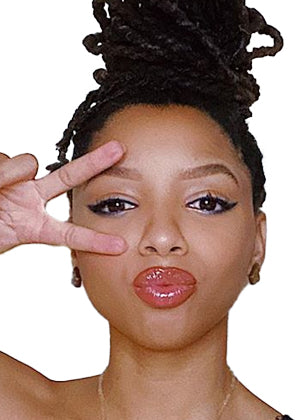How to Add Color to Your Afro Kinky Bulk Hair?
Braids are a wonderful creation embraced by black women and remain a favorite hairstyle for black girls. By using different braiding techniques such as three-strand braids, French braids, Dutch braids, fishtail braids, and cornrows, people have created a variety of braided styles such as box braids, knotless braids, Fulani braids, Bohemian braids, and Senegalese braids. There is always a style that can satisfy every desire for unique, ethnic, fashionable, and long-lasting hairstyles.
How to dye your afro kinky bulk hair on your own?
Nevertheless, keep in mind that in order to complete the process smoothly, you need to allow enough time and prepare the products required for the tasks ahead.
Basic items needed for dyeing your hair
Mixing bowl and brush
Hair dye
Comb
Gloves
Shampoo and conditioner
Basic steps to dye your hair strands yourself
Here is a list of general steps you can follow when planning to dye your 100% human hair strands:
Preparation
Make sure to wear gloves to protect your hands from harsh chemicals. Also, check that your hair is free of any knots and tangles before moving on to the next step.
Mixing
Follow the instructions on the product you are using, such as "box dye" like Dark and Lovely or Revlon, and use a mixing brush to mix all the ingredients into the mixing bowl. Make sure that all the ingredients are well and evenly mixed before moving on.
Coloring
Divide your hair into small sections and coat your hair with the solution from step 2. This should be done from the roots to the ends. Make sure to brush through each section thoroughly so that the dye is evenly applied to each strand. Then repeat this step until all of your hair is covered with the dye.
Rinse
After leaving the dye on your hair for the amount of time specified in the product instructions, rinse thoroughly. This should be done by using plenty of shampoo to remove any residue.
Apply Conditioner
Last but definitely not least, go ahead and deep condition your hair. This will help restore moisture to your hair and make your hair look as good as possible after the process is complete. Rinse thoroughly and then let your hair air dry as much as possible. Congratulations, you are all set and ready to get your new hair color.
Things to Avoid When Dyeing Your Hair
When dyeing your hair, it is important to take precautions to ensure successful and satisfying results. Here are some things to avoid when dyeing your hair:
Avoid using box dyes that contain harsh chemicals, such as excess ammonia or metallic salts.
Avoid bleaching too frequently, as this can weaken the hair structure, leading to damage, dryness, and breakage.
Avoid using excessively hot water. Hot water strips the hair of its natural oils, causing it to become dry and more susceptible to damage.
When choosing a hair dye color, avoid making it too different from the original color of your extensions.
During the dyeing process, handle your extensions gently. Avoid pulling or rubbing hard, as this can cause tangling and damage to the hair.
Avoid using too much hair dye, as this can saturate the hair, causing uneven color absorption and possible damage.
Stick to products designed to work together. Avoid mixing hair dye with incompatible products, as this can affect the chemical reaction and lead to undesirable results.
By taking these precautions and following the steps that come with your hair dye, you can increase your chances of getting the color you want while maintaining the quality of your human hair extensions.
FAQ
What hair dye should I use for human hair braids?
For human hair extensions, you can use regular hair dye or a professional hair dye product. Choose a dye that is appropriate for your type of extension and follow the manufacturer's instructions.
How do I do a strand test before dyeing a full set of extensions?
Remove a small section of hair from the extensions and apply the dye as directed. Rinse, dry, and evaluate the color results. This way you can see how the hair reacts to the dye and make any necessary changes.
Can I dye previously dyed extensions with a new color?
You can dye existing, dyed extensions; however, the results may vary. It is usually more effective to change colors gradually. Consider the existing color and choose a dye that matches it or covers it well.
How long should I leave the dye on my hairs?
Follow the recommended processing time specified by the hair dye manufacturer. Leaving the dye on the hair for too long can over-process the hair, causing damage.
Key Takeaways
While it is possible to dye hair extensions, there are different processes involved depending on the type of extensions you have. Human hair extensions can be dyed just like your natural hair. But remember, the quality of your hair will affect how well it takes and retains color.
It’s also important to follow these simple steps on how to dye your hair at home to ensure you get the color you want without damaging your extensions. Avoid things that can damage your human hair extensions for long-term use.
Conclusion
These basic instructions can only be followed successfully when attempting to dye extensions that are 100% natural human hair. Also, keep in mind that when you dye your own extensions, you should consult a professional first to get the best results if you want to dye them blonde, pastel, gray, etc. This will prevent you from ruining your tresses and having to buy new ones.
Welcome to Exyhair
Are you looking for the perfect human hair series for you? Hair is a very personal thing and it's natural to feel overwhelmed when trying to pick the perfect hair for you.
At Exyhair, we have a wide range of human hair to choose from, whether you're looking for a classic, we'll make sure you get the perfect hair to suit your needs.
If have any other questions, please feel free to contact exyhair:
WhatsApp: +1 213-337-7694
Email: support@exyhair.com



















